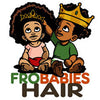If you’re new to hair typing, you’re probably mystified by the letters and numbers that are used to describe texture, density, curl pattern and more. While hair typing should never be seen as categorizing “good” or “bad” hair, it can be a useful tool that enables you to better care for the hair that you were gifted. As a parent, knowing your kid’s hair type(s) will ultimately help you select better natural hair products for babies and children. It’s a win-win for both of you!
What elements of hair should I be looking at?
When you’re thinking about your child’s hair type, you should be looking at the following five elements…
- Hair type
Understanding hair type is essential to choosing the right products and the right hairstyles. Without knowing your hair type, you may be mistreating your hair without even realizing. Skip to the sections below to learn more about the four different types of hair.
- Hair texture
Hair texture comes down to fine, medium or coarse. Texture is determined by the diameter of each individual strand of your child’s hair. How well your child’s hair holds in certain hairstyles will be determined by their hair texture.
- Porosity of hair
Determining how porous hair is tells us how much moisture it needs to stay hydrated. If your child’s hair is porous, then it requires a lot of moisture (think conditioner) to avoid being dry.
- Hair elasticity
Hair elasticity is how easily hair breaks or how flexible it is. If your child has low hair elasticity, it means it’s prone to breakage, which needs to be treated by certain products that highlight strengthening! You should also avoid using certain brushes that can damage the hair even further.
- Sebum production of the scalp
Sebum production is the oil production of your scalp, which can determine whether or not a child has an oil scalp (which may appear greasy), a balanced scalp, or a dry scalp with dandruff flakes. Knowing what issues your child’s scalp regularly encounters can help you treat it with the right products.
The four different types of hair
There are four main types of hair: straight (1), wavy (2), curly (3), and kinky (4). Bear in mind that your child can also have a combination of these types of hair on their head. The best way to evaluate the type of hair that your child has is by leaving it free from product for a few days, giving it a good shampoo, conditioning it, and then allowing it to air dry. However your child’s hair air dries is how their hair naturally is. A child with completely straight hair after air drying obviously has straight hair. If there is a slight wave to it, but it doesn’t curl up then it is considered wavy. If your child has larger curls, but they are not tightly wound, then your child has curly hair. If your child has tightly wound curls, then their hair is considered kinky.
Now, when you begin to see the letters and numbers used together, here’s a quick map to what exactly what it means.
1a = Straight hair that’s fine and thin
1b = Straight hair that has lots of body
1c = Straight hair that’s coarse and hard to curl
2a = Wavy hair that’s fine and thin
2b = Wavy hair that’s medium and frizzy
2c = Wavy hair that’s coarse with thicker waves
3a = Curly with the diameter of sidewalk chalk
3B = Curly with the diameter of a sharpie
3C = Curly with the diameter of a pencil
4A = Kinky with curl the diameter of a needle
4B = Kinky with zigzag curl pattern
4C = Kinky with no curl pattern
While the number refers to the hair type (straight, wavy, curly, kinky), the letter refers to the texture of the hair, how it acts naturally, and how it may hold when styled.
Final thoughts
Picking out hair products for children can be challenging without knowing exactly how their hair type is. Their hair type acts as a road map to how you should be treating and styling it. Once you determine this information, you can select the right natural hair products for them—whether their hair is curly, textured, straight, fine, thin or frizzy!


Leave a comment